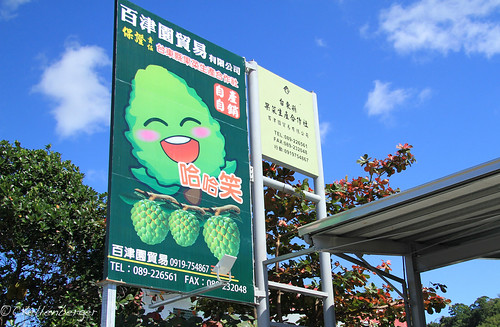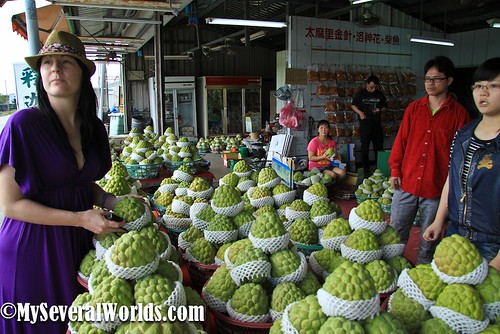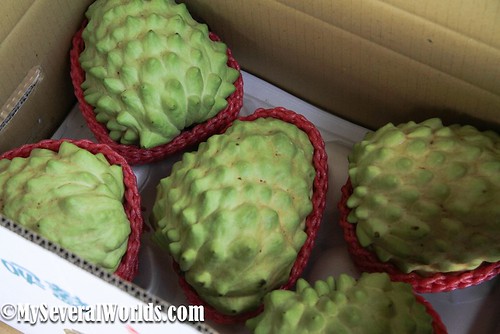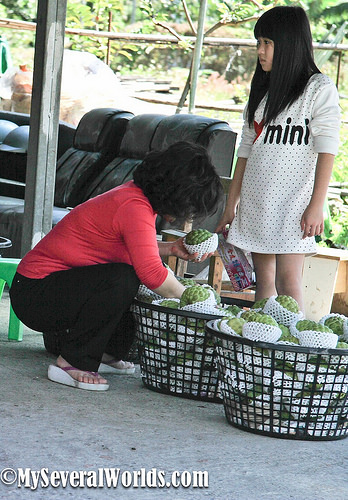
The months of December through March in Taiwan are truly a gift from Mother Nature, in my humble opinion. Taiwan gets hit with some cold weather in winter, and inhabitants of the island do complain vehemently about this (mainly because of the lack of indoor heating), but overall, January through March are a welcome change in my mind.
A gorgeous clear blue sky comes along to just often enough to stave off the drudgery of dealing with a long winter, and no one can deny that most of us look forward to soaking in Taiwan’s hot springs at least a few times.
Winter in to me means that Taiwan’s flower seasons start anew, and winter produce becomes available in abundance. Cherries and strawberries can suddenly be found everywhere, and other exotic fruits that we only see once a year make a brief appearance.
The custard apple is one such product, and while it may not be considered to be a beautiful fruit with its knobby green bumps and giant black seeds, it can certainly be called one of the most delicious!
Taiwan is home to a variety of custard apples known as sek-kia; the fruit is delectably creamy, white and beautifully sweet. It really tastes like you’re diving into a cup of custard, except this custard is all natural.
It’s that delightful. Fruit has never tasted so good.


Driving around Southern Taiwan in Taitung County, you’ll see family-owned custard apple stands and blue farm trucks carrying bushels of this fruit all over. Taitung County is home to close to 5,000 hectares of custard apple cultivation areas in Taiwan, with Taitung County’s Beinan Township producing approximately 40% of the crop. Taiwan is famous for producing a hybrid of custard apples as well, called pineapple-custard apples. The main seasons for this sweet fruit is December through February.
Taiwanese refer to the fruit as Buddha-head fruit because of its resemblance to Buddha’s head. (This is one of Taiwan’s many endearing traits – Finding similarities between their world and Mother Nature, hence Little Taiwan, the Taiwan Sweet Potato, the Queen’s Head Rock, etc.)
Custard apples in Taiwan are also known as sugar apples. Despite being sweet, the glycemic index of the custard apply is quite low, and they come loaded with vitamin C, thiamine, potassium, and dietary fibre. They are an exceptionally healthy fruit that have been touted for their anti-diabetic properties for hundreds of years in India and the Peruvian Andes. Custard apples are bought ready to eat. Served raw, you can simply cut one in half and scoop the sweet, white flesh out, but they’re also great in smoothies, and they’re pretty yummy in dessert dishes too.
You can also find custard apples in Taipei grocery stores and night markets, and if you’re lucky, you’ll happen upon a local vendor like I do every once in a while. I never fail to buy at least a few. Taiwanese custard apples are typically much larger than your average custard apple, and they spoil quickly, so I always keep in mind that I can only eat so much. They only last a few days in the fridge after they’ve ripened, and they get damaged easily if they are mishandled or chilled for too long. They’re ready to eat if the fruit gives slightly when squeezed gently.
Have you ever tried a custard apple? What did you think of it?



Canadian expat Carrie Kellenberger has kept a home base with her husband in Asia since 2003. A prolific traveler, Carrie has funded her travels primarily as a writer, editor, travel blogger and photographer, but she has also worked as an educator, voice over artist, model and nightclub singer. She draws upon her 15+ years of travel experience to write about travel-related issues and the countries she has visited on her award-winning web site, My Several Worlds.
Her photography and travel articles have appeared in both print and online publications around the world, including Travel and Leisure Asia, Unearthing Asia and Hip Compass Escapes.








